Translate Your Shopify Email Notifications for Better Customer Engagement
A Step-by-Step Guide On How To Translate Your Shopify Email Notifications:
ConveyThis is an automatic translation tool that seamlessly translates all the content displayed on your Shopify website, making it easier for visitors to view your content in their preferred language. This includes product descriptions, site navigation, checkout pages, and more. The system uses machine learning to detect the language of your visitors and provide translations instantly. This feature ensures a smooth browsing experience for your international customers, allowing them to access your website in various languages without manual intervention.
However, it’s important to note that while ConveyThis translates the content displayed on your website, it does not automatically translate email notifications sent by your Shopify store. Emails, such as order confirmations, shipping updates, and customer account alerts, are treated separately from your website content. This is because these notifications are not part of the public-facing content of your website and are typically handled by Shopify’s internal email system, which does not integrate directly with ConveyThis for translations.
Even though email notifications are not automatically translated by ConveyThis, there is a solution. ConveyThis provides a method to manually manage the translation of email content based on the language of the order. By using Liquid code, a templating language used by Shopify, you can define how email content is presented to customers in their preferred language. This means that when a customer places an order in French, for example, they will receive the order confirmation email in French, and when a customer places an order in Spanish, they will receive the email in Spanish.
With Liquid code, you can easily create conditional statements that check the language of the order and display the correct translation for each customer. This allows you to ensure that every email sent is personalized and relevant to the customer’s language preference.
Please note that while these instructions cover how to manage the translation of order notifications, they do not apply to certain types of emails, such as Gift Card Creation notifications. These notifications are handled separately and may require a different approach or custom solution. If you want to translate Gift Card emails or other custom notifications, you may need to apply additional modifications or workarounds.
How ConveyThis Translates Website Content:
ConveyThis is a powerful translation tool designed to automatically translate all the visible content on your Shopify website. This includes pages like the homepage, product listings, collections, checkout forms, and even blog posts. The system works by detecting the visitor’s language preferences based on their browser settings or geolocation. Once identified, it translates all static content into the user’s language without the need for manual intervention.
This seamless integration ensures that international customers can browse your website without encountering any language barriers, improving their overall shopping experience. The automatic translation provided by ConveyThis covers the majority of your content, making it ideal for multilingual businesses looking to expand their reach across different markets.
The Challenge of Translating Shopify Email Notifications:
While ConveyThis excels at translating website content, it does not extend its automatic translation feature to Shopify email notifications. This includes crucial customer-facing emails such as:
- Order confirmations
- Shipping and delivery updates
- Account creation or reset notifications
- Password change alerts
- Subscription and promotional emails
Emails are typically handled by Shopify’s internal notification system, which operates separately from the website content. As a result, these notifications are not automatically translated by ConveyThis, and manual intervention is needed to ensure that the content is displayed in the customer’s language of preference.
Notifications for Orders and Shipping:
1. Open a text editor and paste the given liquid code snippet.
To manage email translations, Shopify provides a flexible templating language called Liquid. By utilizing Liquid code in your email notification templates, you can conditionally display content based on the customer’s language preference. This ensures that each customer receives notifications in their preferred language based on the order language or customer’s language settings.
Liquid allows you to insert conditional logic into your email templates, enabling you to create language-specific content for different scenarios. For instance, you can check if the customer’s language is French, Spanish, or any other supported language, and display the translated content accordingly.
Here’s an example of how the translation logic can be set up using Liquid:
{% case attributes.lang %}
{% when 'fr' %}
EMAIL EN FRANÇAIS ICI
{% when 'es' %}
EMAIL EN ESPAÑOL AQUI
{% else %}
EMAIL IN THE ORIGINAL LANGUAGE HERE
{% endcase %}The code provided above is just an example. Please ensure that you input the languages managed in your ConveyThis app that you wish to include for email translation.
Here’s another example for translating emails specifically in German:
{% case attributes.lang %}
{% when 'de' %}
EMAIL IN DEUTSCH HIER
{% else %}
EMAIL IN THE ORIGINAL LANGUAGE HERE
{% endcase %}By implementing the code, if an order is placed in German, the customer will receive the content between the code lines starting with “when ‘de’” and “else”. On the other hand, if the customer places an order in a language other than German, they will receive the content between the code lines “else” and “endcase”. This ensures appropriate language-specific email content for different order scenarios.
{% case attributes.lang %}
{% when 'fr' %}
FRENCH TEXT
{% when 'es' %}
SPANISH TEXT
{% when 'pt' %}
PORTUGUESE TEXT
{% else %}
ENGLISH TEXT
{% endcase %}2. Access your Shopify admin area and navigate to Settings > Notifications. Locate the specific email notification that you wish to translate.
For instance, let’s consider the ‘Order Confirmation’ email that needs to be translated.
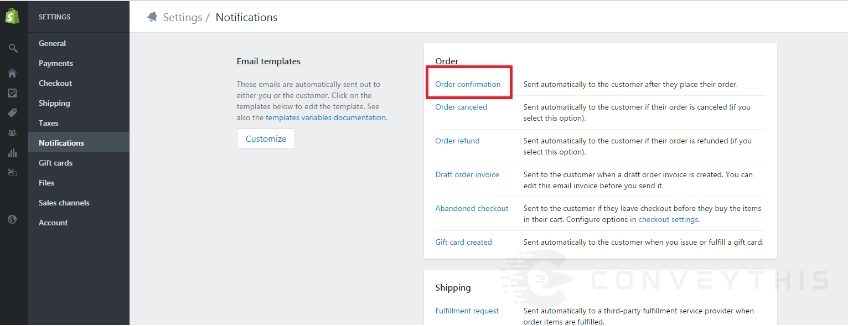
3. Copy the content of the email body.
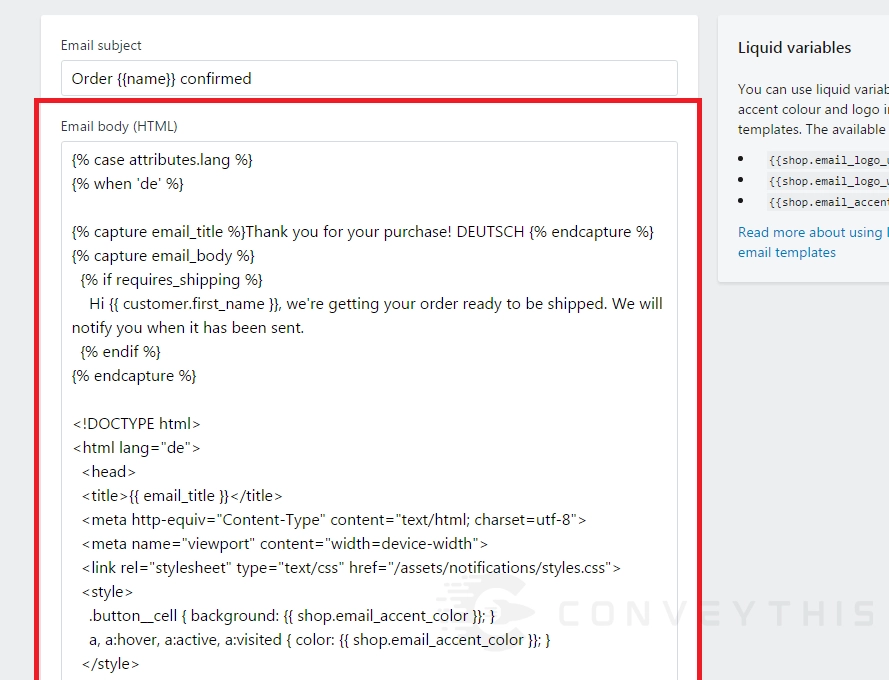
4. Return to your text editor and replace the placeholder text
In this example, since the original language is English, you should replace the placeholder text ‘EMAIL IN THE ORIGINAL LANGUAGE HERE’ with the code you copied.
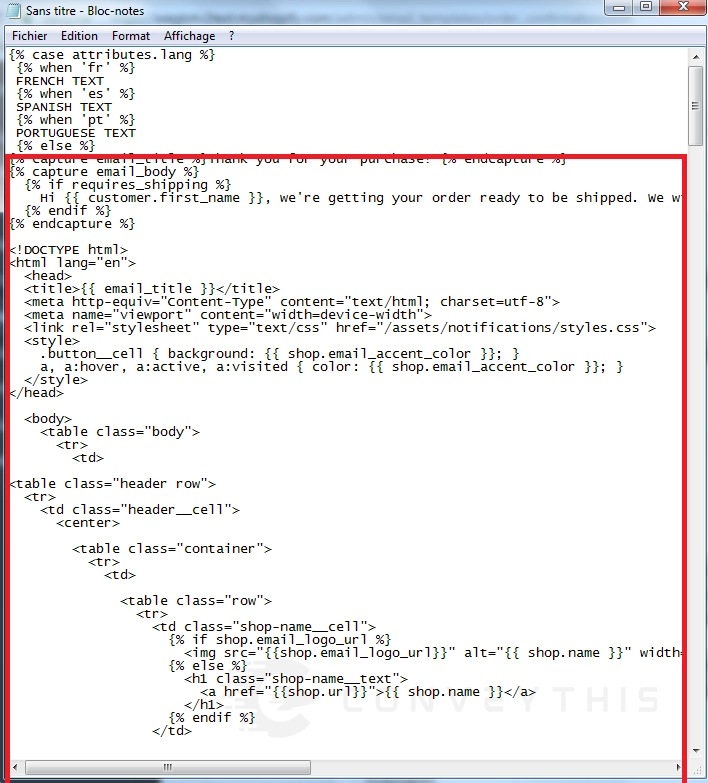
5. Next, replace ‘EMAIL EN FRANÇAIS ICI’ with the same code and modify the sentences with their corresponding translations.
For instance, when translating to French, modify the sentence ‘Thank you for your purchase!’ to ‘Merci pour votre achat !’ Remember to only modify the sentences and avoid translating any liquid code between {% %} or {{ }}.
In this case, locate the ‘Order Confirmation’ email within your Shopify admin area, and paste the translated content from the text editor into this specific email section.
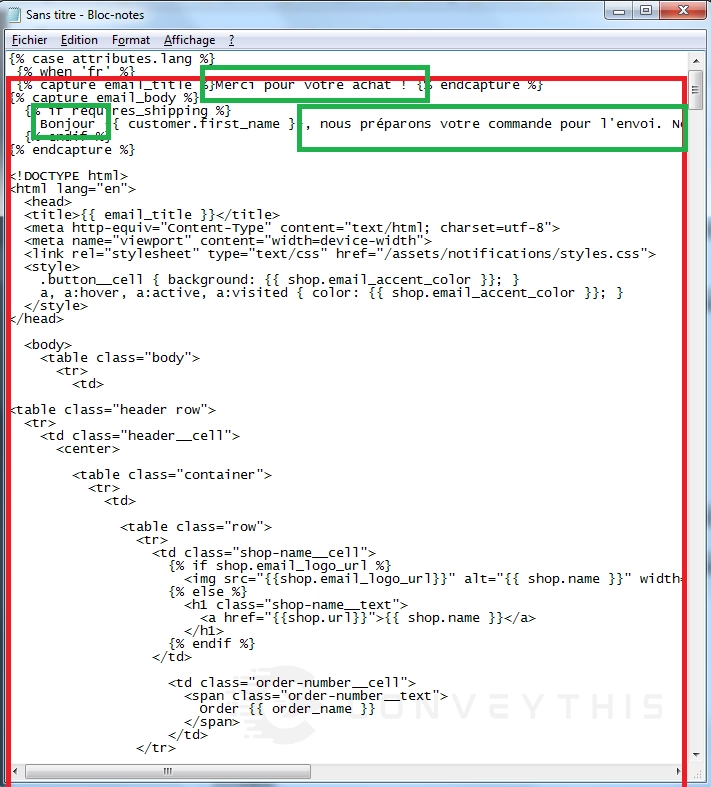
6. Copy the entire content from the text editor and paste it into the corresponding notification section within your Shopify admin area.
In this case, the email edited is ‘Order Confirmation’:
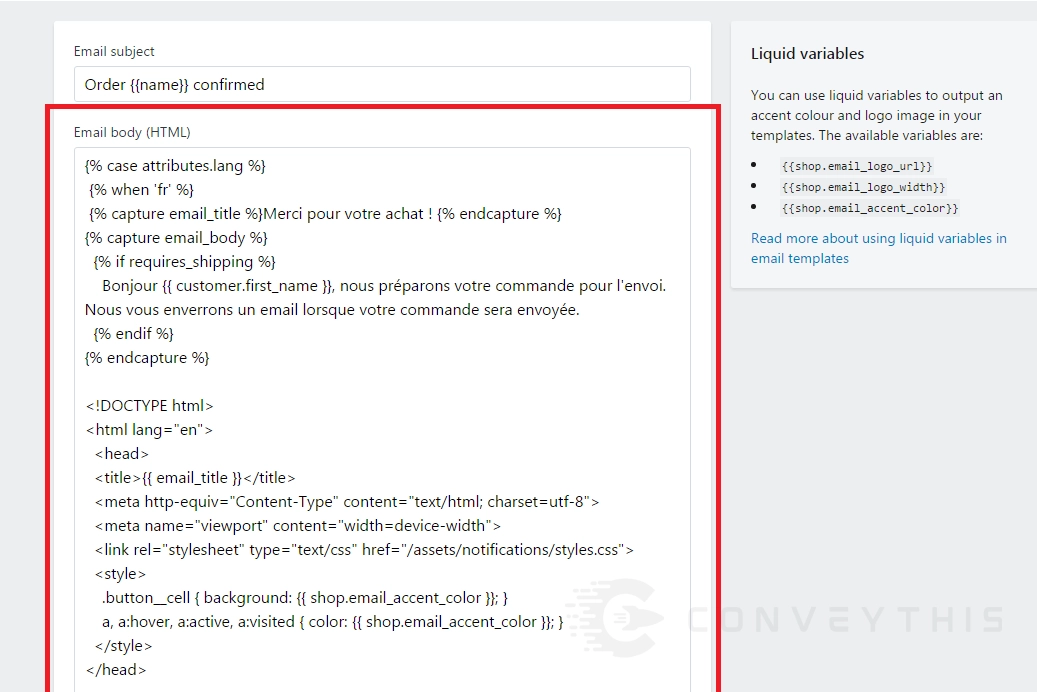
7. Follow the same steps for translating the title of the email.
You can apply the same process to translate the subject of the email. Copy and paste the code into a text editor, then replace the fields with the translated version of the subject. Here’s an example to illustrate the process:
{% case attributes.lang %}
{% when 'fr' %}
Commande {{name}} confirmée
{% when 'es' %}
Orden {{name}} confirmada
{% when 'pt' %}
Pedido {{name}} confirmado
{% else %}
Order {{name}} confirmed
{% endcase %}Then, paste the translated subject from the text editor into the ‘Email subject’ field in your Shopify admin area.
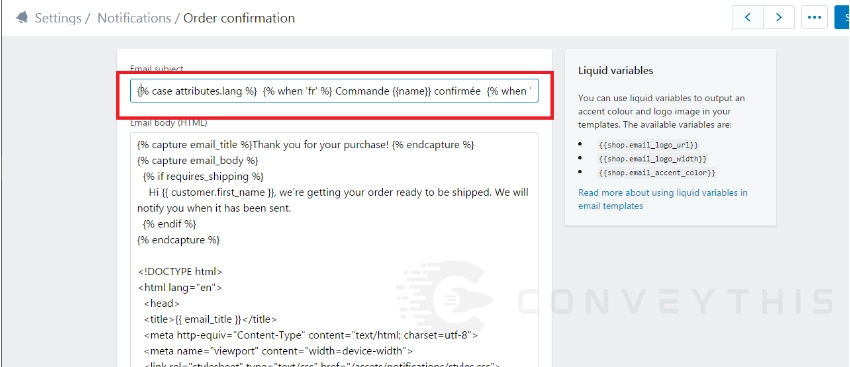
Notifications for Customers:
In addition to translating order-related emails, you may also want to translate other customer-facing notifications, such as account confirmations, password resets, and promotional emails. One way to handle this is by utilizing the customer’s language preferences, which can be tracked using customer tags.
When a customer signs up on your Shopify store, their preferred language can be assigned as a tag (e.g., #ct-fr for French, #ct-es for Spanish). This allows you to customize email notifications based on the customer’s language preference. To enable this feature, you need to add a small snippet of code to your Shopify theme.
[REDACTED]
<script id="has-script-tags">
ConveyThis.initialize({
api_key: "YOUR_KEY",
customer_tag: true
});
</script>Once the language tag is added to the code, you can proceed to create customer notifications following the same schema mentioned earlier in this guide. However, for this part, you will need to utilize the following code:
{% assign language = customer.tags | join: '' | split: '#ct' %}
{% case language[1] %}
{% when 'en' %}
English account confirmation
{% else %}
Original Customer account confirmation
{% endcase %}We value your feedback! If you have any comments or suggestions regarding this article, please feel free to share them with us. Your feedback is important to us and helps us improve our content.
How to Handle Multiple Languages for International Customers:
When running a Shopify store that caters to an international audience, it’s essential to ensure that your customers receive content in their preferred language, especially for email notifications. Offering multilingual email notifications enhances customer experience by allowing them to understand critical information, such as order confirmations, shipping updates, and account management emails, in a language they are comfortable with.
ConveyThis provides a flexible way to manage these translations through the use of language-specific tags, helping you tailor your email content to meet the needs of customers from different regions. By implementing these changes, your Shopify store can effectively engage with international customers and provide personalized communication across various languages.
Testing and Debugging Your Email Translations:
Testing your translations is a crucial step in the email translation process, as it ensures that your multilingual email system is functioning as intended. Without proper testing, you risk sending incorrect or incomplete information to your customers, which could lead to confusion or frustration. Testing is especially important because even a minor issue in translation, formatting, or code can have significant consequences on the customer experience.
Conducting Test Orders in Multiple Languages
The most effective way to test your translations is by placing test orders in different languages. This allows you to see firsthand how the system handles language-specific content. You should simulate orders from customers who speak different languages and go through the entire email notification process. This will help you verify that the correct email is sent for each language, including both the body content and subject lines. It’s also important to check dynamic elements such as customer names, order details, and product information to ensure they are correctly displayed in each language.
When placing test orders, make sure to check for the following:
- Correct language for both body and subject lines: Ensure that the body content of the email matches the correct language and that the subject line is also localized for each language setting.
- Special characters and accents: Some languages use special characters or accents (e.g., é, ü, ñ), so it’s important to ensure that these characters are properly displayed and do not cause formatting issues.
- Personalization: If your emails include personalized elements such as the customer’s name or product recommendations, ensure that these elements are properly rendered in each language.
- Overall email formatting: Verify that the email formatting remains consistent and that the language-specific content doesn’t disrupt the layout or design of the email.
Using Shopify’s Preview Function
Shopify offers a preview option within the notification settings, which allows you to view what your email will look like for different customers based on their language preference. This is a helpful feature for initial testing, as it provides a quick way to verify that the language-specific content is properly inserted into the email templates. However, this preview function should not be your only method of testing. It’s important to also place real orders in different languages to confirm that the emails are sent correctly in a live environment.
Manual Testing and QA
In addition to placing test orders, it’s also a good idea to manually review the translated content. If you’re using professional translators, double-check their work to ensure it’s accurate and culturally appropriate. Mistakes in translation can lead to misunderstandings, which could negatively affect your customer’s experience. Having a native speaker review the translations can help ensure accuracy and authenticity in your emails.
Future Updates and Maintenance:
As your business expands and you add more languages to your website, it’s important to continue updating and maintaining your email templates. New languages may require additional translations for email notifications, and you should ensure that all new content is properly localized for international customers.
Adding New Languages
When adding new languages to your Shopify store, you need to update your email notification templates to include translations for those languages. This process is similar to the initial setup but requires you to ensure that all new emails are appropriately translated based on the customer’s language preferences. You should also review existing translations to ensure they are still relevant and accurate.
For instance, if you add German as a new language for your store, you would need to follow the same steps as outlined in this guide to translate the email content for German-speaking customers. You can apply the same Liquid logic, incorporating the new language code ('de') to handle the German translation, ensuring consistency across all language options.
Monitoring and Updating Translations Regularly
Once your email translations are in place, regular monitoring and updates are essential. Language evolves, and so does your business. As you introduce new products, services, or promotions, you will need to update your email content to reflect these changes. Additionally, customer feedback may reveal areas where your translations need improvement. This ongoing process of monitoring and updating your email translations will help you maintain a smooth and seamless experience for your customers in every region.
You should also stay informed about any updates to the Shopify platform, ConveyThis, or third-party translation tools you use. These updates may introduce new features or improvements that can enhance your email translation process, making it easier to manage and maintain multilingual email content.
Long-Term Benefits of Regular Maintenance
Regular updates and maintenance of your email translations will contribute to improved customer satisfaction and retention. Customers appreciate when brands keep their content relevant and accurate in their preferred language, and providing well-maintained translations will help you avoid issues like incorrect information, broken links, or outdated offers. Furthermore, consistently updated emails reflect a professional brand image and demonstrate your commitment to providing excellent service to all customers, no matter their location or language preference.
In conclusion, testing your translations before going live and keeping your email templates updated as you expand into new languages are crucial steps in ensuring a smooth, professional customer experience. By taking the time to thoroughly test and maintain your email notifications, you can build stronger relationships with your global customer base, ultimately driving growth and success for your Shopify store.
The Impact of Multilingual Email Notifications on Customer Retention:
Offering multilingual email notifications not only improves customer experience but can also play a significant role in customer retention. By speaking to your customers in their native language, you are showing respect for their cultural preferences, which can enhance their loyalty to your brand.
When customers feel understood and appreciated, they are more likely to return for repeat purchases and recommend your store to others. Additionally, multilingual emails help reduce confusion and errors, ensuring that your customers have all the information they need in a language they are comfortable with.
By adopting a multilingual approach to email communication, you are positioning your Shopify store as a customer-centric business that values global audiences and strives to meet their unique needs.
Final Considerations: Testing Your Translations
Testing your translations is a crucial step in the email translation process, as it ensures that your multilingual email system is functioning as intended. Without proper testing, you risk sending incorrect or incomplete information to your customers, which could lead to confusion or frustration. Testing is especially important because even a minor issue in translation, formatting, or code can have significant consequences on the customer experience.
Conducting Test Orders in Multiple Languages
The most effective way to test your translations is by placing test orders in different languages. This allows you to see firsthand how the system handles language-specific content. You should simulate orders from customers who speak different languages and go through the entire email notification process. This will help you verify that the correct email is sent for each language, including both the body content and subject lines. It’s also important to check dynamic elements such as customer names, order details, and product information to ensure they are correctly displayed in each language.
When placing test orders, make sure to check for the following:
- Correct language for both body and subject lines: Ensure that the body content of the email matches the correct language and that the subject line is also localized for each language setting.
- Special characters and accents: Some languages use special characters or accents (e.g., é, ü, ñ), so it’s important to ensure that these characters are properly displayed and do not cause formatting issues.
- Personalization: If your emails include personalized elements such as the customer’s name or product recommendations, ensure that these elements are properly rendered in each language.
- Overall email formatting: Verify that the email formatting remains consistent and that the language-specific content doesn’t disrupt the layout or design of the email.
Using Shopify’s Preview Function
Shopify offers a preview option within the notification settings, which allows you to view what your email will look like for different customers based on their language preference. This is a helpful feature for initial testing, as it provides a quick way to verify that the language-specific content is properly inserted into the email templates. However, this preview function should not be your only method of testing. It’s important to also place real orders in different languages to confirm that the emails are sent correctly in a live environment.
Manual Testing and QA
In addition to placing test orders, it’s also a good idea to manually review the translated content. If you’re using professional translators, double-check their work to ensure it’s accurate and culturally appropriate. Mistakes in translation can lead to misunderstandings, which could negatively affect your customer’s experience. Having a native speaker review the translations can help ensure accuracy and authenticity in your emails.
Future Updates and Maintenance
As your business expands and you add more languages to your website, it’s important to continue updating and maintaining your email templates. New languages may require additional translations for email notifications, and you should ensure that all new content is properly localized for international customers.
Adding New Languages
When adding new languages to your Shopify store, you need to update your email notification templates to include translations for those languages. This process is similar to the initial setup but requires you to ensure that all new emails are appropriately translated based on the customer’s language preferences. You should also review existing translations to ensure they are still relevant and accurate.
For instance, if you add German as a new language for your store, you would need to follow the same steps as outlined in this guide to translate the email content for German-speaking customers. You can apply the same Liquid logic, incorporating the new language code ('de') to handle the German translation, ensuring consistency across all language options.
Monitoring and Updating Translations Regularly
Once your email translations are in place, regular monitoring and updates are essential. Language evolves, and so does your business. As you introduce new products, services, or promotions, you will need to update your email content to reflect these changes. Additionally, customer feedback may reveal areas where your translations need improvement. This ongoing process of monitoring and updating your email translations will help you maintain a smooth and seamless experience for your customers in every region.
You should also stay informed about any updates to the Shopify platform, ConveyThis, or third-party translation tools you use. These updates may introduce new features or improvements that can enhance your email translation process, making it easier to manage and maintain multilingual email content.
Long-Term Benefits of Regular Maintenance
Regular updates and maintenance of your email translations will contribute to improved customer satisfaction and retention. Customers appreciate when brands keep their content relevant and accurate in their preferred language, and providing well-maintained translations will help you avoid issues like incorrect information, broken links, or outdated offers. Furthermore, consistently updated emails reflect a professional brand image and demonstrate your commitment to providing excellent service to all customers, no matter their location or language preference.
In conclusion, testing your translations before going live and keeping your email templates updated as you expand into new languages are crucial steps in ensuring a smooth, professional customer experience. By taking the time to thoroughly test and maintain your email notifications, you can build stronger relationships with your global customer base, ultimately driving growth and success for your Shopify store.
Conclusion:
In today’s global marketplace, offering a personalized and seamless experience to your international customers is more important than ever. With more people shopping online from diverse linguistic backgrounds, providing multilingual support for your Shopify store is essential for building customer trust and loyalty. While ConveyThis automatically translates most of your website content, email notifications remain an area that requires manual intervention to ensure customers receive the right message in their preferred language.
By utilizing Liquid code, Shopify store owners can effectively translate email content based on the customer’s language, offering tailored messages that resonate with each recipient. Whether you are translating order confirmations, shipping notifications, account creation emails, or custom alerts, the ability to customize email content in multiple languages ensures that your customers understand the information they are receiving, improving their overall experience with your brand.
The step-by-step process of translating emails using Liquid allows for a high degree of language customization. You can apply language-specific content for different types of notifications, from transactional emails to promotional messages. This is especially important for businesses with a global reach, as it demonstrates a commitment to inclusivity and customer satisfaction.
However, the translation process doesn’t end with the implementation of Liquid code. Testing, debugging, and ensuring the accuracy of translations is crucial for providing a consistent and professional experience for your customers. It’s also important to monitor your email campaigns and ensure that all customer interactions are in the appropriate language, especially as your business grows and you expand into new markets. Regularly updating your Shopify email templates to reflect new translations will ensure that no customer feels left out, no matter their preferred language.
Incorporating multilingual email notifications can significantly enhance your relationship with international customers, helping to drive customer retention, reduce confusion, and foster a sense of connection with your brand. Customers who receive communication in their native language feel more valued and are more likely to return for future purchases. Additionally, by offering clear and accurate information in the right language, you can minimize misunderstandings, improve customer satisfaction, and boost your overall conversion rates.
Ultimately, providing multilingual email notifications is not just about translation; it’s about making your international customers feel heard, respected, and supported. By taking the time to invest in this crucial aspect of your Shopify store, you are not only enhancing your store’s accessibility but also positioning your brand as a global player that is ready to serve customers worldwide with personalized, language-specific communication.
By implementing the strategies outlined in this guide, Shopify store owners can easily manage and optimize their email translation process, ensuring that every customer receives the information they need in the language they understand best. As you continue to expand your online store and reach new markets, this approach will help you build stronger relationships with your customers, boost retention, and ultimately achieve greater success in a competitive global marketplace. Proper language customization in your email notifications will make sure that your customers’ language preferences are respected, helping your Shopify store thrive as an international business.
Additional Resources:
- ConveyThis Integrations to explore compatibility with Shopify.
- How to Translate Shopify Checkout Page for more guidance.
- Help Guide for Translation Your Shopify Email Notifications for step-by-step support.
Translation, far more than just knowing languages, is a complex process.
By following our tips and using ConveyThis , your translated pages will resonate with your audience, feeling native to the target language.
While it demands effort, the result is rewarding. If you’re translating a website, ConveyThis can save you hours with automated machine translation.
Try ConveyThis free for 3 days!
 No card details
No card details



